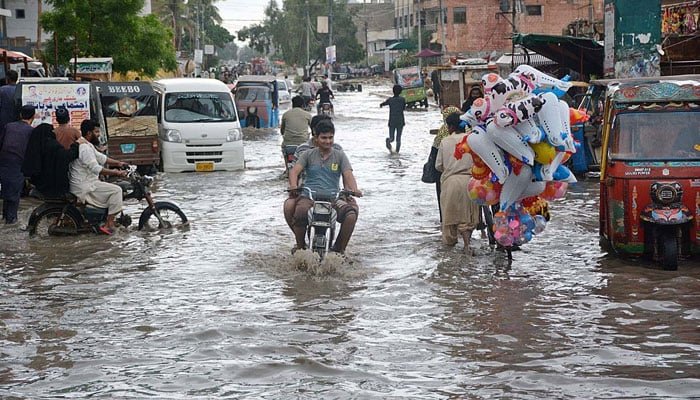Table of Contents
TogglePakistan Grapples with Devastating Monsoon Rains: 14 Dead in 24 Hours, Dozens Injured, Thousands Affected
KARACHI / ISLAMABAD / HYDERABAD / PESHAWAR / LAHORE — Torrential monsoon rains have brought destruction across Pakistan, killing at least 14 people in the past 24 hours and displacing many more. The most recent fatalities include six deaths in Khyber Pakhtunkhwa, five in Punjab, and three in Hyderabad. As the nation braces for further downpours, emergency services are on high alert while citizens continue to suffer under widespread flooding, power outages, and collapsing infrastructure.
According to the National Disaster Management Authority (NDMA), the monsoon season, which began in late June, has so far claimed 111 lives across the country, including 53 children. The majority of the deaths have occurred in Punjab province, with electrocution and flash floods emerging as the leading causes.
Monsoon Carnage in Khyber Pakhtunkhwa
The northwestern province of Khyber Pakhtunkhwa has been particularly hard-hit. Over the past 24 hours alone, six people lost their lives in rain-related incidents. These included:
-
A woman in Bajaur was killed when a boundary wall collapsed on her home.
-
In Khyber district, two children were swept away by rapidly rising floodwaters.
-
A man in Kohat died after the roof of his house collapsed due to the downpour.
-
In Malakand, two more children perished when a wall caved in on them.
Provincial authorities have issued warnings for flash floods in hilly areas and river valleys, urging citizens to avoid travel to vulnerable regions.
Punjab: Collapsing Roofs, Lightning Strikes, and Urban Flooding
Punjab has seen five more fatalities due to the unrelenting rain. Among the incidents:
-
In Okara, 50-year-old Samina was killed when her house gave way to floodwaters.
-
Two teenagers, Anam and Asad, died after being struck by lightning in the same district.
-
A tragic roof collapse at a madrasa in Manchinabad resulted in the deaths of two young students, 8-year-old Salam and 10-year-old Saifullah. Twelve others, including a teacher, sustained serious injuries.
In Kasur’s Haveli Nathu Wali area, a dilapidated room collapsed, killing 42-year-old Omari Bibi and injuring two others. Several additional injuries from similar collapses were reported in Muzaffargarh and Kot Addu.
______________________________________________________________________
Arshad Nadeem & Neeraj Chopra to Compete for First Time After Olympics in Diamond League Showdown
Read This Article
______________________________________________________________________
Hyderabad: Infrastructure Fails Amid Sudden Deluge
In Hyderabad, a powerful monsoon spell brought life to a standstill. Beginning around 4 PM and continuing until sundown, the rain inundated neighborhoods, choked drainage systems, and paralyzed traffic. Streets turned into rivers as drainage systems failed under the pressure.
The Timber Market area saw the collapse of a lumber warehouse roof, killing a laborer named Nek Mohammad and injuring three others. According to the Meteorological Department, 94 mm of rainfall was recorded in the city, while areas near the airport received 56 mm.
Emergency services responded to nine separate incidents of fallen trees and assisted citizens trapped in flooded streets. Hyderabad Electric Supply Company (HESCO) came under heavy criticism as over 200 power feeders tripped, halting operations at key drainage pumping stations.
Angry residents expressed outrage over the unpreparedness of the Hyderabad Municipal Corporation. Officials, including Mayor Kashif Shoro and Commissioner Zahoor Ahmed Laghari, faced backlash for not cleaning storm drains prior to the monsoon season. Trash-clogged exits further exacerbated the flooding.
Sindh Chief Minister Syed Murad Ali Shah took notice of the situation and ordered the immediate restoration of electricity and removal of standing water. He directed the Sindh Energy Minister to coordinate with HESCO and emphasized the urgent need for city officials to stay on the ground.
Urban Paralysis in Lahore and Central Punjab
Lahore, Pakistan’s second-largest city, was battered by intermittent heavy rainfall that caused feeder trips across the grid, resulting in widespread power outages. Low-lying areas such as Township, Canal Road, and Gulberg saw significant waterlogging, disrupting daily life. Temperatures cooled slightly, bringing relief from the heat, with highs expected around 33°C.
Other cities in Punjab were also affected:
-
Okara received 72 mm of rain
-
Sahiwal 66 mm
-
Dera Ghazi Khan 51 mm
-
Mianwali 38 mm
-
Bahawalpur 36 mm
-
Kot Addu 33 mm
-
Gujranwala 30 mm
-
Layyah 23 mm
-
Murree 22 mm
Lighter rainfall was also reported in Rawalpindi, Attock, Sialkot, Faisalabad, Toba Tek Singh, and Multan. Power disruptions were reported throughout the region due to feeder trips.
In Dera Ghazi Khan, rain from the Koh-e-Sulaiman mountains caused flooding in low-lying slums, submerging over 20 informal settlements and forcing families to evacuate. Kamalia experienced similar conditions, with water entering homes and streets, and extensive power outages being reported.
River Flow and Flood Alerts
The Provincial Disaster Management Authority (PDMA) of Punjab reported that most rivers remain at normal flow levels, with the exception of the Indus River at Taunsa, where moderate flooding was recorded at 426,000 cusecs. Other rivers—Chenab, Ravi, Jhelum, and Sutlej—were flowing within normal limits.
However, Dera Ghazi Khan’s Vidor Rudkohi is currently experiencing dangerously high flood levels. Local administrations have been put on alert amid predictions of increased water flow in the coming days.
Balochistan Cut Off, Harnai Faces Isolation
In Balochistan, heavy rains have severed road connections to Harnai district as rivers and canals overflowed their banks. The region now stands cut off from the rest of the province. The PDMA has activated emergency protocols and advised citizens to contact helpline 1129 in case of emergencies.
National Weather Forecast: More Trouble Ahead
The Pakistan Meteorological Department (PMD) has forecast another strong monsoon system affecting most of the country between July 15 and 17. The system is expected to merge with a westerly wave, potentially triggering intense rainfall, thunderstorms, and strong winds.
Forecasts include:
-
Khyber Pakhtunkhwa: Widespread rain in Peshawar, Swat, Abbottabad, Dir, Mansehra, Chitral, Bannu, and the tribal districts. Flash floods are likely in hilly areas such as Galliyat, Malakand, and Kohistan.
-
Punjab and Islamabad: Heavy showers in Lahore, Kot Addu, and Sadiqabad, with high chances of urban flooding.
-
Sindh and Balochistan: “Very heavy to extremely heavy” rainfall between July 14 and 16.
-
Azad Kashmir and Gilgit-Baltistan: Rain-wind-thunderstorms with scattered heavy rainfall.
-
Riverine Areas: Rising water levels in River Chenab and Tarbela Dam may lead to flooding in surrounding areas.
Emergency Preparedness and Public Advisory
The PMD, PDMA, and NDMA have jointly issued public safety advisories, urging people to:
-
Avoid unnecessary travel, especially in vulnerable hilly or riverine regions
-
Stay indoors during lightning storms
-
Keep emergency kits ready
-
Follow official announcements and updates via verified government channels
District administrations across provinces have been directed to activate emergency control rooms, ensure the availability of rescue equipment, and coordinate with local health departments for swift medical responses.
In areas like Taunsa Sharif, rising waters in the Indus River have already submerged critical bridges, cutting off transport routes. Residents have been seen setting up makeshift camps along higher ground, as many criticized the absence of functional relief camps and official shelters.
Conclusion: A Nation Underwater
As Pakistan enters the peak of its monsoon season, the country finds itself once again grappling with deadly floods, broken infrastructure, and governmental unpreparedness. With over 100 lives lost in just three weeks and many more at risk, the monsoon of 2025 is shaping up to be one of the deadliest in recent memory.
Authorities are urging citizens to remain vigilant, heed weather warnings, and prioritize safety. With another intense weather system moving in, the next 72 hours are critical for emergency response teams and local governments .alike




